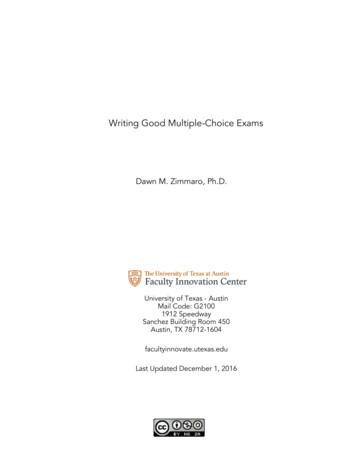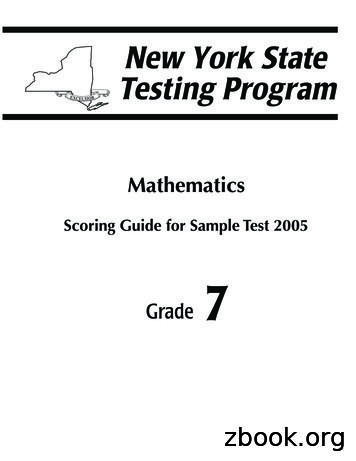HINTS TO MULTIPLE CHOICE QUESTIONS
MHT-CETTRIUMPHCHEMISTRYHINTS TO MULTIPLE CHOICE QUESTIONS&EVALUATION TESTS
CONTENTSr. No.TextbookChapterNo.Chapter NamePage No.Std. XI11Some Basic Concepts of Chemistry122States of Matter (Gases and Liquids)835Redox Reactions1747Surface Chemistry2358Nature of Chemical Bond2969Hydrogen42710s-Block Elements4781255913Basic Principles and Techniques in Organic ChemistryAlkanes71Std. XII101Solid State80112Solutions and Colligative Properties87123Chemical Thermodynamics and Energetics106134Electrochemistry121145Chemical Kinetics139156General Principles and Processes of Isolation of Elements165167p-Block Elements171178d and f-Block Elements181189Coordination Compounds1911910Halogen Derivatives of Alkanes and Arenes2062011Alcohols, Phenols and Ethers2272112Aldehydes, Ketones and Carboxylic Acids2512213Compounds Containing mistry in Everyday Life308Organic Reactions31125
TextbookChapter No.01Some Basic Concepts of ChemistryHintsClassical Thinking44.16. BaCl2 H2SO4 HCl BaSO420.8 9.8 7.3 xx 23.321. CH4 2O2 CO2 2H2O(1 vol.) (2 vol.)(1 vol.) (2 vol.)1 cm3 of CH4 requires 2 cm3 of O2 for itscomplete combustion0.25 cm3 of CH4 gives 0.5 cm3 of O2.26.u means unified mass.36.Molecular mass of H2 2 g2 g will contain 6.022 1023 molecules of H2. 1 g of H2 will contain 39. 6.022 1023molecules2mass atomic mass(M)Atomic Mass of O 16Atomic Mass of N 14n V(O) V( N )Molecular formula of benzene is C6H6.Molecular mass sum of atomic weight of allthe atomsMolecular mass 12 6 6 1 72 6 78According to Avogadro’s law, the grammolecule of benzene is equal to 78 g of C6H6.V( N)V(O)41.1 mole of ozone(O3) 48 g 0.5 mole of ozone(O3) 42.Number of molecules n 6.022 102316mass of oxygenNow, n 0.532molar mass of oxygenNumber of molecules 0.5 6.022 1023 3.011 1023 Mass of the substanceMolar mass of the substance 3.011 1023 molecules 3 1023 moleculesAtomic mass of the element 1.792 10 22 6.022 1023 10843. 40. 46.16 1 32 214 1 14 g N2 has number of moles 28 2Number of moles is same, so number ofmolecules is same.V nNumber of moles (n)16 g O2 has number of moles 0.5 48 24 g.12 gram mole of CO2 88 g of CO20.1 mole of sucrose (C12H22O11) 34.2 g ofsucrose1 gram atom of calcium 40 g of calcium1.5 mole of water 27 g of water1.5 mole of water weighs the least amongstthe given options. n (O)n(N) V n 1MM(N)M (O)14 7 16 8 49. The ratio is 7 : 8Urea [H2N – CO – NH2]60 gm of urea contains 12 g of carbon. 100 gm of urea contains50.In Fe(CNS)3.3H2O3 18% of H2O 100 19%28451. 40 gm NaOH contains 16 gm of oxygen 100 gm of NaOH contains12 100 20%6016 100 40% oxygen.4052.Elements59.%AtomicComposition MassA2512.5B7537.5MolesRatio25 212.575 237.52 122 12Hence, the simplest formula of the compoundis AB.1L 10 3m3 103cm3 1dm3 103mL.1
MHT-CET Triumph Chemistry (Hints)21.At S.T.P,22.4 dm3 of any gas 6.022 1023 moleculesMixture of liquids may be homogeneous orheterogeneous mixtures.Physical quantityUnit(A) Densitykg m 3(B) Accelerationm s 2(C) Pressurekg m 1 s 2(D) Forcekg m s 2The magnitude of ‘mega-’ is 106.22.1 mole 6.022 1023 electronsOne electron weighs 9.108 10 31 kg1 mole of electrons weighs6.022 1023 9.108 10–31 kgNumber of moles that will weigh 1 kgN2 3H2 2NH3(1 vol.) (3 vol.)(2 vol.)3 volumes of H2 gives 2 volumes of ammonia2 22 L of H2 will give L of ammonia3 1.33 L of ammoniaA molecule cannot be divided into itsconstituent atoms by simple methods.However, under drastic conditions, it can bedecomposed into constituent atoms. Critical Thinking2.4.5.10. 12.13.Isotopes are the atoms of the same elementhaving same atomic number (i.e., containingsame number of protons and electrons) butdifferent mass number (i.e., different numberof neutrons).14.The natural abundance means percentageoccurrence.16.Molecular weight of sodium oxide (Na2O) 46 16 6262 gm of Na2O 1 mole620 gm of Na2O 10 moles.17.19. Md (d density, M mass, V volume)VSince d 1So, M V18 gm 18 mL18 mL NA molecules (NA Avogadro'snumber)N1000 mL A 1000 55.555 NA.186.022 1023 atoms of H weighs 1 g.Mass of 1 atom of hydrogen 20.216.022 1023 1.6 10 24 g1 gram atom of nitrogen 22.4 L of N(molar volume at N.T.P.) 11.2 L of N2 1moles6.022 10 9.108 10 311 108 moles of electrons will9.108 6.022 23weigh one kilogram.23.18 g of H2O 1 mole 3 NA atoms( Number of atoms n NA Atomicity)11mole 2 NA atoms2211mole 3 NA atoms4.4 g of CO2 101016 g of CH4 1 mole 5 NA atomsmaximum number of atoms is present in 16 gof CH4.16 g of O2 24.Number of atoms n NA AtomicityNumber of S atoms 6.022 1023 0.2 8 9.63 102325.CaCO3 CaO CO210 g 10 g of 90% pure CaCO3 9 gm of CaCO3Number of moles of CaCO3 Mass of CaCO3 in gmMolecular weight of CaCO3 in gm9100 0.09 moleNumber of moles of CaCO3 CaCO3 CO2 0.09 moleAt NTP Vol. CO2 0.09 22.4 2.016 L.27. Molecular mass of CH3COOH 6024% of C in CH3COOH 100 40%60Similarly,Molecular weight of C6H12O6 18072% of C in C6H12O6 100 40%180
Chapter 01: Some Basic Concepts of Chemistry28.Molecular mass of Urea i.e., H2N – C – NH2 is 60.34.O 29. urea has 2 N atoms.mass of N 2 14 2828% of N in urea 100 46.6 %60% of X 75.8% of Y 100 – 75.8 24.2X%Composition75.8Y24.2ElementAtomic ratio75.8 1.0117524.2 2.0212Simplestratio1.011 11.0112.02 1.0111.99 235. 3CaCO3 3CaO 3CO2Molecular mass of CaO is 40 16 563 moles of CaO is formed in the reaction. 3 56 168 g of CaO is formed.36.2H2 O2 2H2ORatio of mole of reactant, H2 : O2 2 : 1Actual amount 3 g of H2 and 29 g of O2.329 1.5 mol of H2 and 0.91 mol of O2.2321.5 1.66 : 1Ratio of actual moles of H2 : O2 0.91Theoretical ratio of moles of H2 : O2 2 : 1Actual ratio of moles of H2 : O2 1.66 : 1Hence, H2 is limiting reactant and O2 is excessreactant.Now, 2 mol H2 give 2 mol H2O.1.5 mol H2 will give 1.5 mol H2O.Thus, empirical formula of the compound isXY2.30.Empirical formula mass CH 12 1 13Molecular mass 78Molecular mass 78 6r Empirical mass 13Molecular formula r Empirical formula 6 CH C6H631. 32.33.Since, 0.0835 mole of compound contains1 gm of hydrogen1gmoleofcompoundcontain1 11.97 12 g of hydrogen. 0.083512 g of H is present in C2H12O6CH4 2O2 CO2 2H2O(12 4) (2 32)(12 32) (2 18)16 g62 g44 g36 g16 g CH4 44 g of CO233 1633g of CO2 44 12 g of CH412Number of moles 16 0.75 moles of methane4Al 3O2 2Al2O3(108 g) (96 g)(204 g)108 g Al combines with 96 g of O296 27 24 g27 g Al combines with108 2NH3N2 3H2 10 mL 30 mL20 mLThus, ammonia obtained in the reversiblereaction of NH3 is 20 mL. 37.Baking soda or sodium hydrogen carbonate(NaHCO3) is a compound. Diamond andcharcoal are different forms of the elementcarbon. 22 carat gold is an alloy of gold withother metals (mainly copper). Hence, it is amixture.38.In compound B, 32 parts of X react with 84parts of Y.In compound B, 16 parts of X react with 42parts of Y.In compound C, 16 parts of X react with xparts of Y.The ratio of masses of Y, which combine withfixed mass of X in compounds B and C, is 3:5. BC 42 35x42 5x 703Competitive Thinking4. Molecular weight of C60H122 12 60 122 1 720 122 8426 1023 molecules 842 g3
MHT-CET Triumph Chemistry (Hints)8426 1023 140.33 10 23 1.4 10 21 g1 molecule 10 19 81 111001081 10.81 1005.Atomic mass 6.Average atomic mass200 90 199 8 202 2 199.96 2001007.Molecular mass of NH3 14 (3 1) 174.25 0.25Number of moles 17Number of molecules of NH3 0.25 NA 1.506 1023 moleculesOne molecule of NH3 contains 4 atoms.1.506 1023 molecules will contain 1.506 1023 4 6.024 1023 atoms 6 1023 atoms. 6.022 1023 dioxygen molecules are present in1 mole i.e., 32 g of dioxygen.1.8 1022 dioxygen molecules will be present1.8 1022 32 0.96 g of dioxygen.in6.022 10238. 9.Number of moles in 4.4 g of CO24.4 0.144Number of oxygen atoms in 1 mole of CO2 2 NANumber of oxygen atoms in 0.1 mole of CO2 0.1 2 NA 0.2 6.022 1023 1.20 1023 10. 11.Volume occupied by 1 mole of any gas at STP 22.4 dm3Volume occupied by 4.4 g of CO2 i.e., 0.1 moleof CO2 at STP 2.24 dm3 2.24 LNumber of atoms n NA Atomicity( It’s a triatomic gas) 0.1 NA 3 6.02 1022 3 18.06 1022 1.806 1023412. 13. 14. 15. 16. Total number of atoms in molecule n NA AtomicityAtomicity of NH3, O2, H2 and He moleculesare 4, 2, 2 and 1 respectively.17 g of NH3 4 NA atoms 4.25 4.25 g of NH3 4 NA NA atoms 17 32 g of O2 2 NA atomsN2 8 NA A atoms8 g of O2 2322 g of H2 2 NA atoms 2NA atoms4 g of He NA atomsThus, the system that contains 2 g of H2 hasmaximum numbers of atoms.1 mole of water 18 g of water 6.022 1023 molecules ofwater18 moles of water 18 6.022 1023molecules of water 1.08396 1025 moleculesof waterSince, 1 mole of BaCO3 contains 3 moles ofoxygen111.5 moles of oxygen 1.5 0.5 moles32of BaCO31 L of air 1000 mL 1000 cc.1000 cc of air contains 210 cc of O21 mole 22.4 L 22400 cc.210number of moles of O2 0.0093 moles.2240022.4 L of water contains NA molecules22400 mL of water contains NA molecules1 mL of water i.e., 20 drops containsNAmolecules224001 drop containsNA6.022 1023 22400 20448 103 1.344 101817.Molecular weight of PbO 207.2 16 223.2Molecular weight of PbCl2 207.2 2(35.5) 278.2223.2 g of PbO gives 278.2 g of PbCl2 6.5 g of PbO will give 6.5 278.2223.2 8.102 g of PbCl2 moles of PbCl2 obtained 8.102 0.029 moles.278.2
Chapter 01: Some Basic Concepts of Chemistry18. 19.20.21. 22. Since, 0.5 g Se 100 gm peroxidase anhydrousenzyme100 78.478.4 g Se 1.568 1040.5Minimum molecular mass of peroxidaseanhydrous enzyme means molecule atleastcontains one selenium atom.Empirical formula of an acid is CH2O2(Empirical formula) n Molecular formulan whole number multiple i.e., 1,2,3,4.If n 1 molecular formula CH2O2.C 24 g, H 4 g, O 32 gSo, Molecular formula C2H4O2So, Empirical formula CH2O(Simplest formula).Relative number of atoms of38.71 3.22C 129.67H 9.67151.62O 3.2216Simplest ratio : C : H : O3.22 9.67 3.22::3.22 3.22 3.221:3:1Empirical formula CH3O1H2O H2 O22H2 : O2 2 : 1for 2.24 dm3 of O2, H2 liberated will be 4.48 dm3BaCO3 BaO CO2 Molecular weight of BaCO3 137 12 (3 16) 19722.4 L of CO2 is released by 197 g of BaCO3 x L of CO2 is released by 9.85 g of BaCO322.4 9.85x 1.12 L197324. BCl3 H2 B 3HCl23moles of H2 1 mole of B221.6number of moles of B 210.8 x moles of H2 2 moles of Bmoles of H2 3volume 3 22.4 67.2 L C3H8 5O2 3CO2 4H2O(1 vol) (5 vol)1 L of propane gas will require 5 L of O226. 2Al(s) 6HCl(aq) 2Al3(aq) 6Cl(aq) 3H2(g)25.For each mole of HCl reacted 1mole of H2 is2formed.volume of H2 gas formed at STP per mole of1HCl is 22.4 11.2 L.227.1 mole of Mg3(PO4)2 gives 8 moles of O2x moles will give 0.25 moles of O20.25x 3.125 10 2 moles.828.M2CO3 2HCl 2MCl H2O CO2From balanced chemical equation,1 mol M2CO3 1 mol CO2From the data given in the problem,1 g M2CO3 0.01186 mol CO21g M 2 CO 31 mol CO 2Now, 0.01186 mol CO 2 1 mol M 2 CO329.23. 30. 84.3 g mol–1 M2CO3Thus, molar mass of M2CO3 84.3 g mol 1.2H2(g) O2(g) 2H2O(g)Ratio of moles of reactants, H2 : O2 2 : 1Actual amount of reactants: 10 g H2 and64 g O2Actual moles of reactants: 5 mol H2 and 2 molO2Ratio of actual moles of reactants,H2 : O2 5 : 2 2.5 : 1The limiting reactant is O2.Now, 1 mole of oxygen gives 2 moles ofwater. Hence, 2 moles of oxygen will give 4moles of water.2Mg O2 MgO(2 24) (32)48 g of Mg requires 32 g of O20.56 480.56 g of O2 requires 32 0.84 g of MgMg left 1 0.84 0.16 g5
MHT-CET Triumph Chemistry (Hints)31. 32.33. Both O2 and N2 are diatomic.ratio of their number of molecules will beequal to ratio of their number of moles.weight of O 2number of moles of O2 32weight of N 2number of moles of N2 28number of moles of O2 number of moles of N2weight of O2weight of N 2 322814:32 281 1:32 7ratio is 7 : 32Total weight of person 75 kg10 7.5 kgMass due to 1H atoms 75 100Mass of 2H atom is twice that of 1H atom.All 1H atoms are replaced by 2H atoms.Hence, mass increase is twice i.e., by 7.5 kg.MgCO3(s) MgO(s) CO2(g)Molar mass of MgCO3 84 g mol 120Number of moles of MgCO3 0.238 mol841 mole MgCO3 gives 1 mole MgO0.238 mole MgCO3 will give 0.238 mole MgO.Molar mass of MgO 40 g mol 10.238 mole MgO 40 0.238 9.52 g MgOTheoretical yield of MgO 9.52 gPractical yield of MgO is 8.0 g Percentage purity 34. 100 g of haemoglobin contains 0.33 g of Fe67200 g of haemoglobin contains67200 0.33 100 221.76 g of Fe.221.76Number of atoms of Fe 56 3.96 435.When Avogadro number is 6.022 1023 mol 1,the mass of 1 mol of carbon 12 gMass of 1 mol of carbon when Avogadronumber is 6.022 1020 mol 112 6.022 1020 12 10 3 g 6.022 1023Thus, the mass of 1 mol of carbon is changed. 36. 0.1 mol of XY2 10 g1 mol of XY2 100 gi.e, Molecular weight of XY2 1000.05 mol of X3Y2 9 g1 mol of X3Y2 180 gi.e., Molecular weight of X3Y2 180Let atomic weights of X and Y be x and yrespectively.x 2y 100 .(1) .(2)3x 2y 180Substrating (1) from (2),2x 180 100x 40Substituting x 40 in (1),40 2y 100y 308 100 84%9.52Evaluation Test2.Molecular mass of N2O4 28 64 92 g54 0.59 molesnumber of moles 92Molecular mass of CO2 12 32 44 g28 0.64 molesnumber of moles 44Molecular mass of H2O 2 16 18 g36 2 molesnumber of moles 18Molecular mass of C2H5OH 24 6 16 46 6 3.46 1 mole46Water has more moles.Largest number of molecules is present in 36 gof water.number of moles Mass of 6 1023 molecules of water 18 g186 1023 3 10–23 g 3 10–26 kg.Mass of 1 molecule of water
Chapter 01: Some Basic Concepts of Chemistry5.I.Mass of 1 molecule of O 32NA32 10 236.0231414 10 23Mass of 1 atom of N N A 6.02311. II.III.IV. Mass of 1 10 10 mole of O2 32 10 10Mass of 1 10 10 mole of Cu 63 10 101432 10 23 10 23 32 10 10 63 10 106.0236.023Therefore, the correct order of increasingmasses for given species is II I III IV.6.C2H4(2 12) 428 g 7.8. 9. 2 3264 g28 g of ethylene requires 64 g of O22.8 kg of ethylene will require2.8kg 64g 6.4 kg of O228g12. 13. 14. 2PH3(g) 2P(s) 3H2(g)2vol100 mL 2O2 2CO2 2H2O 03volx2 vol. of PH3 gives 3 vol. of H2100 mL of PH3 gives x mL of H2100 3x 150 mL of H22change in volume 150 100 50 mL increasemassvolumeAt STP, 1 mole of any gas will occupy 22.4 Lof volume.mass of 1 mole of gas molecular mass45density 2.008 2 g/L.22.4Density 1 molecule of PCl3 4 atoms1 mole i.e., Avogadro number (NA) of PCl3molecules will contain 4 NA atoms.1.4 moles of PCl3 4 1.4 NA atoms 3.372 1024 atoms10.4NH3(g) 5O2(g) 4NO(g) 6H2O(g)4 moles of NH3 reacts with 5 moles of O2 1 mole of NH3 will react with i.e., 1.25 moles of O2.only 1 mole of O2 is available, all the O2 willbe consumed.5moles of O24 S O2 SO21 mole of O2 gives 1 mole of SO25 moles of O2 will give 5 moles of SO2Molecular mass of SO2 32 2 16 64mass of SO2 formed 64 5 320 g14 0.5 mole.14 g of CO 281 mole of CO occupies 22.4 L at NTP0.5 mole will occupy 11.2 L1 molecule of CO contains 1 oxygen atom6.02 1024 CO molecules contain6.02 1024 oxygen atoms.1 gram atom 6.02 1023 atoms6.02 1024 oxygen atoms 10 gram atomof oxygen.A hydrocarbon contains H and C only.% of carbon 80%% of hydrogen 20%80 6.66Relative number of carbon atoms 1220Relative number of hydrogen atoms 2016.66 20Simplest ratio : 1 : 3.6.66 6.66Empirical formula CH318.The SI unit of mass is ‘kilogram’ and not‘gram’.19.According to the given data, reactant B is thelimiting reagent. Hence, the amount of Cformed will be 3 moles.20.In first experiment:2.70 g of copper oxide contain 2.16 g ofcopper.% of copper 2.16 / 2.70 100 80 %In second experiment:1.83 g of copper oxide contain 1.46 g ofcopper.% of copper 1.46 / 1.83 100 79.8 %Therefore, percentage of copper in copperoxide is approximately 80 %.Since the percentage of copper in both thesample of copper oxide is nearly same, theabove data illustrates the law of definiteproportion.7
TextbookChapter No.02States of Matter (Gases and Liquids)Hints42.Classical Thinking7.Gases do not have definite shape and volume.Their volume is equal to the volume of thecontainer.20.Krypton, an inert gas, exists as a monoatomicgas. Ozone is a triatomic gas whereas fluorineand hydrogen are diatomic gases.23. F 25.The SI unit of pressure is Newton per squaremeter (Nm 2). It is called Pascal (Pa).51.According to Boyle’s law, at a constanttemperature for a given mass of an ideal gas,pressure is inversely proportional to the volume.59.33.99 C 32 (0) 32 32551P V1P (m/d) 44.50.72. P dm P d ( m constant)37.Temperature in K 10 273 263 K38.initial volume V1final volume V2 2V1initial temperature T1 0 C 273.15 Kfinal temperature T2V1 V2 T1 T2T2 3.6.7.T1 V2 273.15 2V1 546.30 KV1V1T2 546.30 K 546.30 273.15 273.15 C39.V1 V0T1 273 KT2 10 C 10 273 283 KV1 V2 T1 T2V2 8T2 V1 283 V0T1 273 11.T1 300 1P 1 and P2 2P1 i.e., 1 T2 600 2P2 2P1 T1 P2 T2According to Gay Lussac’s law this happenswhen V is constant.V will remain same i.e., 5 LOne mole of a pure gas always occupies22.4 dm3 at STP.P V2.46 atm 10 LT 1mol 0.0821L atm mol 1 K 1n R 299.63 KDispersion forces increase with the mass of themolecule. Among H2, Cl2, O2 and N2, Cl2 hashigh molecular mass. So Cl2 is easy to liquefy.The pressure exerted by a gas is due to collisionsof gas molecules with the walls of the container.According to Charles’ law, V T.Critical ThinkingSolids are also non-crystalline in nature.Intermolecular forces of attraction keep themolecules together. Intramolecular forces ofattraction hold the constituent atoms of themolecule intact in the molecule. This is due toformation of chemical bonds between theatoms of the molecule. So, intermolecularforce of attraction are much smaller than theintramolecular force of attraction.Molecular attraction keeps the moleculestogether while the thermal energy providesmotions to the molecules and increases thetendency to escape from attractive forces ofneighbouring molecules. In gaseous state, themolecules have least intermolecular attractionand highest kinetic energy as compared to that insolid and liquid state. So in gaseous state thermalenergy is far greater than the molecular attraction.Strength of ion-dipole interaction depends oncharge and size of the ion. Smaller the size of theion, stronger is the interaction. Cations beingsmaller in size than anions, Na – H2O interactionwill be stronger than Cl– – H2O interaction.
Chapter 02: States of Matter (Gases and Liquids)12.13.14.16.17.20.21. 23.24.On dissolution of NaCl in water, almostcomplete dissociation of NaCl and formationof Na (cation) and Cl (anion) takes place.Na and Cl ions are separated from each otherand both undergo process of hydration.Higher magnitude of charge along with smallersize of the ion leads to concentration of charge.Hence, such a hydrated ion will show strong iondipole interaction. Among Na and K , Na issmaller as it has one orbit less as compared to K .Na , Mg2 and Al3 belong to the same period. Aswe move from left to right in a period, theatomic/ionic size decreases. Al has the smallersize and has 3 charge on it. So, Al3 will showstrong ion-dipole interaction on hydration.In a collection of atoms, the instantaneousdipoles may induce temporary dipoles in theatoms or molecules in the vicinity and theninteract with these induced dipoles. Thisinteraction produces dispersion forces.Intermolecular hydrogen bond
CHEMISTRY MHT-CET TRIUMPH. CONTENT Sr. No. Textbook Chapter No. Chapter Name Page No. Std. XI 1 1 Some Basic Concepts of Chemistry 1 2 2 States of Matter (Gases and Liquids) 8 3 5 Redox Reactions 17 4 7 Surface Chemistry 23 5 8 Nature of Chemical Bond 29
Developing multiple choice and other objective style questions 4 2. Writing multiple choice questions THE FORMAT of a multiple choice question Multiple choice questions are the most commonly used format for presenting objective-style questions. A multiple choice question consists of two parts ñ A stem and several options or alternatives.
Figure 1: A two-tier multiple-choice question in the format suggested in this paper, used in an exam in 2014. 2Description and design of our two-tier multiple-choice questions 2.1Basic structure of our two-tier multiple-choice questions There are several different ways to formulate two-tier multiple-choice questions. The type of
AUE 2602 – Exam hints 2015 Page 1 AUE 2602 – EXAMINATION PREPARATION – UNISA 201 5 : . AUE 2602 – Exam hints 2015 Page 2 PAST EXAMINATION QUESTIONS June 2013 June 201 5 Topic Questions J . (Solutions Tut Letter 103) Especially GOWER: UNISA says Keep the notes for quick reference before the exam!!! AUE 2602 – Exam hints 2015 .
Test Blueprint 10 Preparing to Write Items 11 Description of Multiple-Choice Items 12-15 Multiple-Choice Item Writing Guidelines 16-18 Guidelines to Writing Test Items 19 Sample Multiple-Choice Items Related to Bloom’s Taxonomy 21-23 More Sample Multiple-Choice Items 24-25 Levels of Performance and Sample Prototype Items 26 Good versus Poor Multiple-Choice Items 27-28 Activity: Identifying .
Using multiple choice questions in the classroom How multiple choice questions can aid knowledge retention and help teachers diagnose pupils’ understanding. Why might I use multiple choice questions with my students?
50 multiple choice. 5. field test 40 multiple choice field test 46 ITEMS/40 POINTS 45 ITEMS/40 POINTS 55 ITEMS/50 POINTS 45 ITEMS/40 POINTS. 12 Students compose two essays one, for each of. two writing prompts. 40. multiple choice. 5. field test. 49. multiple choice. 1. open ended. 6. field test 50 multiple choice. 5. field test 40 multiple .
MapReduce 642 Additional Studying 644 XII. Cod Librare y 645 HashMapList 646 TreeNode (Binary Searc h Tree) 647 LinkedListNode (Linked List 64) 9 Trie & TrieNode 649 XIII. Hint 65s 2 Hints for Data Structure 65s 3 Hints for Concepts and Algorithms 662 Hints for Knowledge-Based Question 67s 6 Hints for Additional Review Problems 679 XIV.
Grade 7, Book 1 Question Type Points Strand Content Performance Indicator Answer Key 1 Multiple Choice 1 Number Sense and Operations 7.N.9 C 2 Multiple Choice 1 Algebra 7.A.1 G 3 Multiple Choice 1 Statistics and Probability 6.S.3 A 4 Multiple Choice 1 Number Sense and Operations 7.N.6 H 5 Multiple Choice 1 Geometry 7.G.3 B























